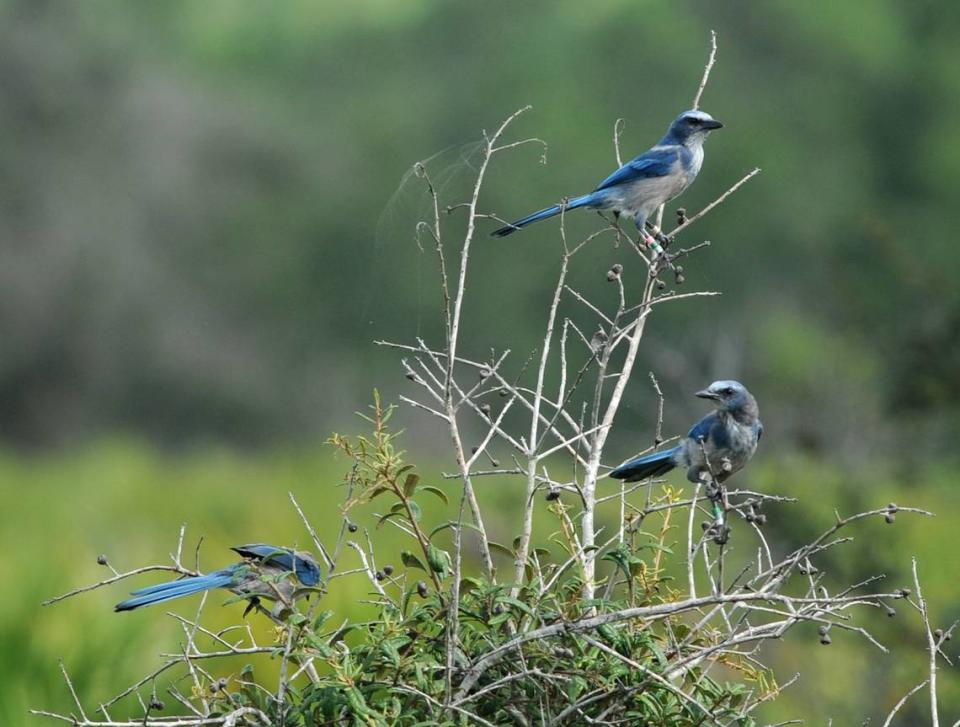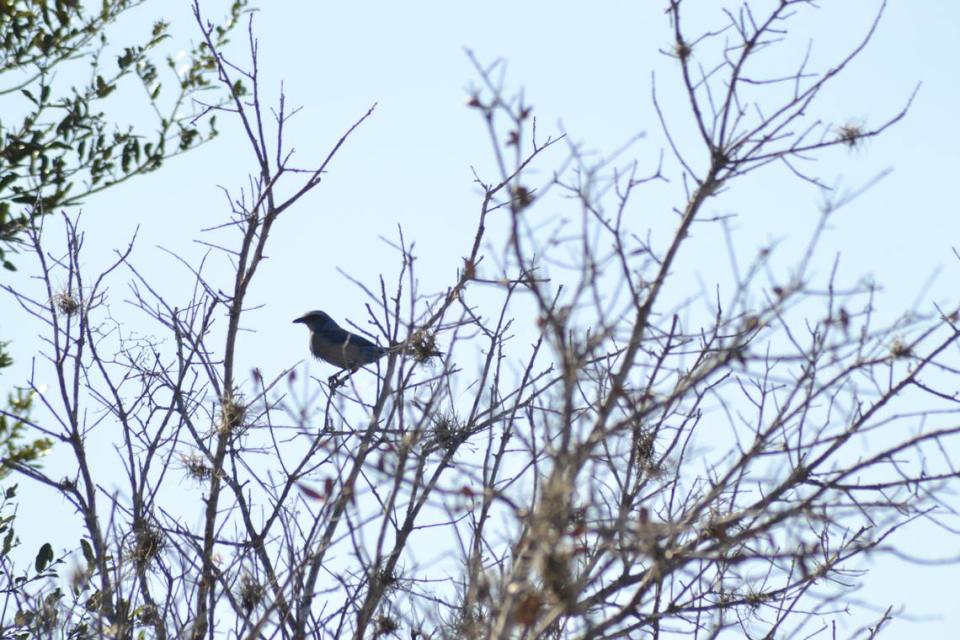Florida’s native bird is disappearing. Is the state protecting them in Manatee County?
Conservationists are raising concerns that a threatened bird may not be getting the help it needs to survive on state-owned lands in Manatee County and Southwest Florida.
The Florida scrub jay is the only bird that’s entirely unique to Florida, and it’s in big trouble.
The bright blue and famously friendly songbird makes its home in a special habitat — scrub — that development has massively wiped out or fragmented. Scrub also needs periodic wildfires to thrive, and human prevention of this natural phenomenon has further contributed to the habitat’s disappearance.
The result: Scrub jay numbers were down over 90% to less than 10,000 birds across the state by 1993, according to Audubon Florida, with further losses since.
The scrub jay population centered around Manatee County’s Duette Preserve is one of the few in the state that is increasing instead of declining. Ecologists contribute this success to conservation efforts and careful land management, including prescribed burns.
But conservationists say that’s not always the case at neighboring state-owned land in Manatee County managed by the Southwest Florida Water Management District.
In interviews with the Bradenton Herald, experts expressed concerns that state conservation lands have become overgrown without timely prescribed burns. It’s a problem they fear could drive scrub jays away and leave the endangered birds with fewer places to nest.
Numbers show scrub jay loss at SWFWMD preserve
Scrub jay survey numbers provided to the Bradenton Herald by Florida Audubon show a seeming decline and disappearance of the birds at Little Manatee River Southfork Tract, a 971-acre preserve managed by SWFWMD east of Parrish and north of State Road 62 in East Manatee County.
Scrub jays had consistently been present at the preserve from 2012 to 2020, when surveyors spotted an average of two scrub jay families per year, with a peak of three groups in 2015.
But from 2021 to 2023, not a single scrub jay has been recorded there.
However, Audrey DeRose-Wilson, Audubon Florida’s director of bird conservation, believes the site can still support scrub jays.
“The jay population at Little Manatee River Southfork Tract has declined and no jays have been detected there since 2020,” DeRose-Wilson said in an email. “However, the SWFWMD has continued to manage scrub habitat at Southfork in hopes that jays will return. I saw this site in 2022 and there was sufficient managed habitat to support Scrub-jays but no jays yet.”
Other state-managed sites have seen positive trends.
Bird numbers at SWFWMD’s 5,800-acre Gilley Creek site have generally increased, as have numbers at Moody Branch, a 960-acre site managed by the Florida Fish and Wildlife Conservation Commission (FWC).
But conservationists argue that progress could be lost if lands are not consistently managed.
Conservationists concerned for Florida scrub jay’s future
Zach Holmes, an avian ecologist who has surveyed and studied scrub jays for years, said SWFWMD lands have a history of poor management for scrub jay habitat.
“A lot of that is due to lack of management in the form of prescribed fire,” Holmes said.
Holmes estimates that SWFWMD owns about 30% of the public lands where scrub jays are found in Southwest Florida, including three large land tracts in Manatee County.
“All of these areas are really, really important to jays,” Holmes said.
Holmes said the success of scrub jay recovery in East Manatee County is the result of “robust management and collaboration” between several sites, including Manatee County’s Duette Preserve, FWC’s Moody Branch and Mosaic’s Wellfield site.
“There is a highly collaborative effort in the region, and unfortunately SWFWMD has not been a part of that,” Holmes said. “There have been efforts by several entities to convince SWFWMD to either do management or accept help in the form of equipment or labor to better manage the land for the benefit of jays. Unfortunately, none of that has been successful in recent years.”
He described the agency as “the last piece of the puzzle” in managing East Manatee County’s public lands for the success of scrub jay recovery.
Kay Prophet, an ornithologist and past president of the Manatee County Audubon Society, agreed that land management on state properties has been an issue for years.
“The reality is our properties up here all got ridiculously overgrown,” Prophet said. “They were seven or eight years ago the worst I’ve ever seen them.”

Without fire, scrub lands are taken over by other plants and eventually turn into a different habitat. And scrub jays, which settle in one place for life, are understandably picky about choosing their forever home.
“They pick the best possible spot,” Prophet said.
Prophet said she has noticed improved efforts to apply prescribed burns at SWFWMD sites in the last few years. But she questioned whether the agency has enough staff and resources to keep up. The agency oversees 16,000 acres in Manatee County alone.
“It’s probably going to take years to get that land back under control,” Prophet said. “All of us that love the scrub jay would like to see this improve.”
Prophet said she previously tried to organize volunteer groups to help manually clear overgrowth on state-owned land — another technique for maintaining healthy scrub jay habitat. But the state turned down the volunteer power because of liability issues.
“They say no or they don’t respond at all,” said Vivienne Handy, president of Quest Ecology. The ecological consulting company helps Manatee County manage threatened species like the scrub jay at Duette Preserve and has also tried to offer SWFWMD volunteer assistance to manage its land.
“It’s very frustrating,” Handy said. “What happens next door affects the wildlife we are trying to protect.”
SWFWMD: Scrub jay is not our charge
In response to concerns about scrub jay habitat, a spokesperson for the SWFWMD said that the agency’s primary concern is protecting state “water resources and natural systems.”
“It’s important to note, the District does not manage wildlife species in Florida,” SWFWMD spokesperson Susanna Martinez Tarokh said in an email. “These natural systems include important habitat for Florida’s numerous species, including the scrub-jay, but the District does not conduct single species management. However, when an imperiled or endangered species is present on District conservation lands, the District does conduct land management activities responsibly.”
SWFWMD staff said the agency has applied prescribed fire to over 420 acres of the Manatee River Southfork Tract over the last 10 years.
SWFWMD staff said prescribed burns planned for summer 2023 and spring 2024 at the Southfork Tract were canceled due to drought conditions.
SWFWMD directed further questions about the management of the scrub jay to a different state agency, the Florida Fish and Wildlife Conservation Commission.

Better land management could help ensure scrub jay’s future
Michael Elswick, a division manager of Manatee County’s Natural Resources Department, said better land management in East Manatee County could further improve the health and numbers of the local scrub jay population — and every family of birds counts.
“It is still possible to secure the long-term prospects of this population,” Elswick said in an email. “Additional family groups need to be formed on suitable habitat to allow this to happen.”
As of July 2023, there were 24 scrub jay family groups on Duette Preserve and 50 to 60 family groups in the broader area.
Elswick said the county and its partners, including Mosaic and state agencies, are about halfway towards a goal of 100 breeding pairs of jays on high-quality habitat.
“These efforts require a commitment to do maintenance of the habitats in perpetuity,” Elswick said. “This primarily involves the regular application of prescribed fire ... and the control of invasive plant and animal species that would otherwise disrupt and dominate these habitats.”
The county prescribes fire to portions of Duette every year, rotating through different areas.
Elswick said more consistent burns and more aggressive invasive plant control could improve scrub habitat in other parts of Manatee County, but he noted the maintenance efforts are “challenging and require adequate funding to implement.”
Holmes encouraged SWFWMD to accept help managing its lands.
“We all understand that water management districts were created maybe not with the intent of managing for listed species,” Holmes said. “But it’s arguably an egregious violation to knowingly have listed species on their property without at least allowing collaborators to assist with management, even if (SWFWMD) doesn’t have the capacity to do it themselves.”
Optimism for scrub jay in Manatee County
With each family of jays requiring upwards of 20 acres of habitat, Holmes said more conservation land buys through programs like Manatee County’s Environmental Lands Program could also help expand their territory.
What about the scrub jay’s future?
“I’m still optimistic,” Holmes said. “There have been a lot of historic declines. But Eastern Manatee County is a really hopeful area, which is why getting this management is so important.”
Prophet said that it’s not just SWFWMD that needs to do better.
“Why aren’t we all doing more for this species?” she said. “Let’s not wait until they go on the soon-to-be-extinct list. We have a beautiful setup here, unlike many other places in the state where populations are declining and will probably wink out.”
Prophet remains hopeful that jays will come back to the Southfork Tract. She’ll be on the lookout for them during this year’s Jay Watch bird count, which happens in June and July.
“I love these birds. They’re the most charismatic birds I’ve ever seen, and I’ve been around birds my whole life,” Prophet said.


